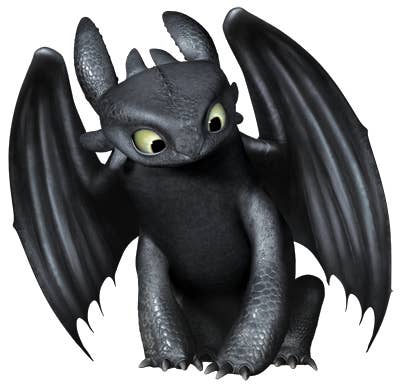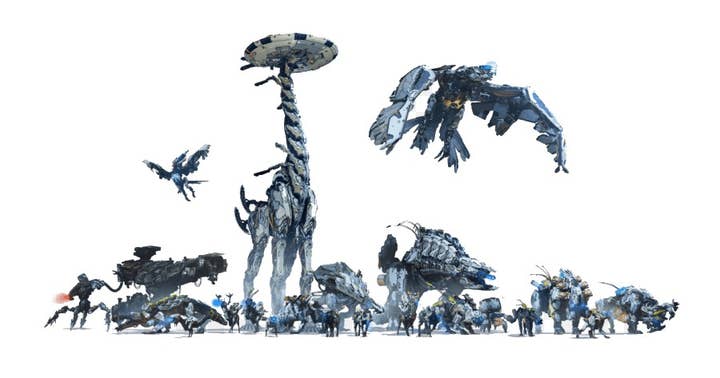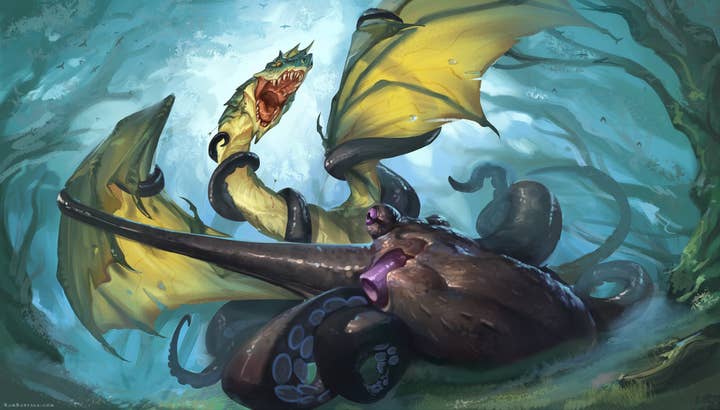Creature feature: An expert’s guide to making memorable monsters
At Develop:Brighton, Sam Santala explored ways game artists can make creatures more lifelike and not just a bag of bones and meat
Video games have brought us an incredible range of memorable and iconic creatures over the decades, from Trico in The Last Guardian, to Creepers in Minecraft, Goombas in the Mario series, Big Daddies from BioShock, Final Fantasy's Chocobos, or Gorons in the Zelda franchise.
In a Develop:Brighton talk entitled 'Bringing Creatures to Life: How to Make Good, Emotionally Appealing Creature Designs', Sam Santala detailed the foundations for making creatures come to life in a way that makes sense for games, whether they're monstrous foes or adorable allies.
Santala has worked as a senior concept artist since 2014, working on games such as Rare's Everwild, Ubisoft's Might & Magic: Elemental Guardians, ArenaNet's Guild Wars 2, or Avatar: Pandora Rising. In 2020, he launched Songhorn, his outsourcing art studio focusing solely on creature design.

"I love creatures both real and imaginary," he explained. "I think that creatures have this special ability to create an emotional connection with us, and through games we can create really appealing creature designs that are able to speak to us in a way that other aspects of games can't."
He admitted that creature design can sound like a "very niche area of game design" but clarified that it's actually pretty broad and can include:
- Killable enemies
- Friends & partners
- Mounts
- Races/Characters
- Creatures as environments
"Creatures design is not simply four-legged creatures, it's all sorts of things," he said. "If you understand the principles of anatomy, evolution and aesthetic, you can create some amazing designs that aren't humanoid."
Table of contents:

Think about your creature's function
In games, "all creatures should ultimately try and serve a function," Santala said. And thinking about that purpose, that appeal, should be the starting point of any design.
"Appeal is essentially when a creature's design adheres to its emotional or functional core," he said. "What is the core of the creature? [Some creatures are] designed to simply exist, show you where its weak spot is and give you something to hit.
"[But] if you design creatures that don't have these emotional cores or these functional cores, I feel like you end up with creatures that are more like an exercise in simply moving shapes around. They're not really achieving a goal. They're just existing. It's fine to do if you're just practising, but if you put one of those inside a game, it might distract from the purpose of the game. Focusing on that functional or emotional core is absolutely paramount to creating a design that's both memorable and functional."

Santala took an example from outside of games to explain his point: Toothless from the How to Train A Dragon series (see right). He said Toothless is very effective in switching between its two functions: dangerous and threatening on one hand, and adorable on the other.
Know your anatomy basics
In order to be a good creature designer, you have to really hone in on real-life animal anatomy, Santala continued. It's good to know those rules so you know when you're breaking them, or why you're breaking them if you're doing it on purpose.
"You have to study your basics, and typically the best ones are horses and dogs, because they have such an emotional connection to us as people," he said. "Similarly to how we can just tell if something's wrong with someone's face because we're so [familiar] with it, we feel the same way about dogs and horses. And basing designs on those things tend to [trigger] stronger emotional responses than something like an insect.
"This real life anatomy even comes into fold when you're designing things that aren't specifically organic as well. So think of Horizon Zero Dawn, for instance. All of those creatures (see below) are very robotic but they use extremely representational mechanical parts that resemble animal anatomy. We intrinsically understand what that should look like, how that should feel. There are elements to them that are strictly robotic but the fact is that they're grounded in our reality because we understand anatomy."

However, while anatomy is important, Santala clarified that it's not everything. He took the example of raptors in the Jurassic Park franchise, which for decades have caused endless debates because they don't accurately represent what these creatures looked like.
"There's a level of truth to that [but] I thought the designs were still solid," Santala said. "I thought they appealed to that core that is supposed to be horrific and scary but also likeable, and while I think that the anatomy helps, I don't think that by adjusting the anatomy of those designs, it would have made them fulfil that role any better. The whole point of those designs is to be terrifying, to be exactly what they ended up being.
"And again, anatomy helped, but it's like expanding your vocabulary. If you try to put a sentence together with only a few words, you'll have a sentence but it won't be that good. But if you only know long words and you have no idea about grammar or eloquence, you're going to not have a particularly beautiful sentence either. To me, that's what anatomy is; it's a tool. Something that you can expand, but something that you should apply carefully."
"You don't have to learn all the minutiae, you just have to learn these blueprints, and anatomy and creatures become a lot easier"
He admitted that anatomy is a "tricky balancing act" as animals can be extremely varied on the anatomy plan, contrary to humans. But the best way to proceed is to simplify things, focus on the "key forms," and compare what you're doing with anatomy you know as bones are similar across species.
"By learning those landmarks, you can find that you don't have to learn all the minutiae, you just have to learn these blueprints, and anatomy and creatures become a lot easier," he added.
He ended this portion of the talk with quick anatomy tips when it comes to designing creatures:
- Lifestyle influences an animal's shapes (herbivores are generally thicker and predators tend to be thinner, designed for speed)
- If an animal needs something, it'll be bigger (ie. bats have big ears)
- Depending on the heat, animals become smaller or bigger (ie. fennec foxes vs arctic foxes)
- Study prehistoric life for rare inspiration

Focus on key focal points and flow
Focusing on key forms also serves a purpose linked to your creature's core function and the relationship the player is going to be building with it.
"By focusing on a few select key areas you can tell that functional or emotional core much more effectively than you would by having too many of them," Santala explained.
"You should focus on the key points of the design. So if it's a killable enemy maybe it has a weak spot or a weapon. But if it's something you're trying to relate to, something that you're trying to learn and emote to, think of how they express themselves, think of markings on their body, but make them obvious. Make them readable enough that the player can see that, question that, and ultimately want to learn more about them.
"Each focal point should explain or enhance the function of the core. Anything additional to that, if this creature had something random on it that is distracting, it would be harder to understand and it might create frustrating gameplay, which is the last thing we want to do."
He once again took an example from Horizon Zero Dawn, in this case the game's Grazers (see below, right). On these creatures, the contrasting colours and their flow draw attention to what's important on them: the yellow canisters.
.png?width=720&quality=70&format=jpg&auto=webp)
"Your key areas should either be immediately noticeable or should be telegraphed to the player using flow, using shape language, using silhouette, using anything you can use to try and guide the players' eyes to those key areas," Santala said.
Add personality
Sometimes in games, creatures are just "treated like objects" with their only function being "to exist and to be shot,” Santala said. But creatures are "characters in their own rights," he added. You can (and should) add personality to them.
"Even [with] just some small things, you can really bring out a personality in a creature. Some examples could be a set of scars, or ageing. Maybe they've got more wrinkles, maybe they've got longer horns, maybe they're sagging, maybe they've got chipped teeth. But maybe it's not just the physical design of the creature. Maybe it's posture, it's gait, how it moves and interacts.
"By trying to understand these creatures, we can try and make them more relatable. What is it trying to do at the moment? Is it hungry? Is it tired? Is it wounded? Is it proud? These are things that are small changes but can make a great difference to how especially the emotional core of these creatures resonates with our audience.
"Are we just designing a bag of bones and meat with some horns on it and hoping that the audience understands it? Or are we designing characters that are in animal form but allow us to resonate and empathise, and sometimes fear?"
"Creatures have an ability to touch the soul and to inspire a sense of wonder, love and connection"
He gave three general tips for adding personally to a character:
- If you're stuck on a creature and are trying to build emotional connection, design its baby as it immediately helps you relate to its adult version more
- If you're trying to design a creature that's eerie and as far removed as possible from us, remove the eyes (the more distant a design is from humans, the scarier it gets)
- Need a more relatable creature? Just make it a dog (ie. Maximus, the horse in Disney's Tangled, who actually behaves like a dog)
Concluding his talk, Santala said that creature design is about creating emotional resonance, whatever the emotion you're trying to achieve is.
"I focused on rules like anatomy so you can learn how to make the basic building blocks, I focused on focal points so you can explain these points more clearly, and I added personality because I wanted to teach you how to bring these creatures to life and make them more emotional.
"Creatures have an ability to touch the soul and to inspire a sense of wonder, love and connection. I'd like to leave you with one final quote from Harvey Dunn, and he was talking about painting: 'The spirit is the only thing that's true about anything'. Which means if you're creating something without a core, without some spirit or some focal point to it, then it's empty."

